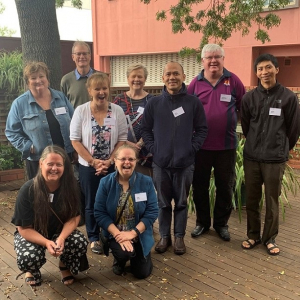Peter MALONE
I am Richard Pryor
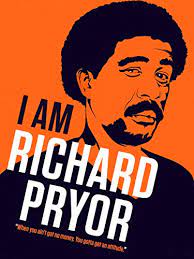
I AM RICHARD PRYOR
US, 2019, 93 minutes, Colour.
Directed by Jesse James Miller.
This portrait of Richard Pryor is one of a series of television portraits of celebrities, especially of film, television and stage. They have been produced by Derek Murray, beginning with Bruce Lee in 2012. Other portraits include Steve McQueen, Paul Walker, Burt Reynolds.
The format is to provide a profile, with some warts and all, of the celebrity. By the end, the audience knows the details of the life of the star, difficulties in upbringing, the motivation for a career, changes in development of career, success, personal failures, significance in American cultural history of the 20th century.
International audiences may be familiar with Richard Pryor from his appearance in movies, especially in such films as Silver Streak, Stir Crazy and his collaborations with Gene Wilder. Americans may be familiar more familiar with his historical television appearances during the 1960s and 70s, later, his range of special television programs. Richard Pryor was a distinctive presence.
The screenplay gives a lot of attention to Richard Pryor’s origins in Peoria, Illinois, born in 1940, growing up in a brothel managed by his grandmother, his mother being one of the prostitutes, his father being a pimp. He was placed in the custody of his grandmother while growing up and had a devotion to her.
Early in his career, influenced by Bill Cosby and his appearances on television, during his 20s, Richard Pryor made quite an impact, imitating Cosby, going on many television shows, including Ed Sullivan, which catered for a wide audience. He also began to make film appearances in the 1970s, including a serious appearance with Diana Ross in Lady Sings the Blues, about Billie Holiday, and later the films with Gene Wilder into the 1980s, working with Sidney Poitier. However, he also went to Las Vegas, walked out, took a break, seemingly having a significant change of mind and heart in his decisions about performing, moving towards the black audience, revealing the background of his life, the themes, speaking to the minds and hearts of this audience. This was confirmed by support from Lily Tomlin, inviting Richard Pryor onto her program and her performing with him in a sketch that offended some of the white executives. Lily Tomlin is one of those talking heads throughout the film, significant in admiration for Pryor.
Also present is his former wife, his fourth, Jennifer Lee Pryor. She is particularly frank about her love for Pryor, the difficulties, trying to care for him, it being too much, her leaving, but with the development of his MS, coming back to care for him. At the end, she is seen pouring his ashes into the ocean in Hawaii, at a haven that they use to come to.
There are many black voices, comedians Tiffany Haddix and Mike Epps, director, Michael Shultz, and a number of directors and historians. There is quite some admiration for Pryor, an emphasis on his ability to communicate with the black audiences, articulating black issues – with the rough and tumble and language of the stand-up comedians of the time.
The film is also frank in its acknowledgement of Pryor’s lifestyle, his many relationships with women, three wives and divorces, the marriage to Jennifer Lee, the drugtaking of the period, the range of drugs, his free-basing, the accident with fire (suggesting a death wish), his continued relapsing.
A portrait of flawed genius. An acknowledgement of his place in the American consciousness, especially of race issues.
Free Guy
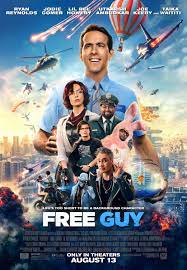
FREE GUY
US, 2021, 115 minutes, Colour.
Ryan Reynolds, Jodie Comer, Taika Waititi, Lil Rel Howery, Joe Keery, Utkarsh Ambudkar, Aaron W Reed.
Directed by Shawn Levy.
This reviewer is not a gamer (though seeing many films of games and gamers), so expectations of watching and enjoying were not particularly high, but advertisements were around for a very long time during lockdown, Ryan Reynolds bemused face looking out at us, so some hopes for comedy. And, apart from thinking about the equivalent of Truman in Peter Weir’s The Truman Show, Truman unwittingly and cheerfully locked in a popular television show all his life), ready to enter the gaming world. And, there was Guy, 20 years after Truman, cheerful and unwittingly (“don’t have a good day – have a great day!”), Going through his daily routines, cereal for breakfast, bank robbery in the afternoon, all these strange bespectacled avatars, a nice guy.
Being of a generation where a tutorial on how computer games work is essential for appreciating the creativity of the minds behind them, the imaginations, of what the effect is on the gamers – and an explanation of the gamers and the visualising of their avatars on screen – I was not so caught up in the technology but the emerging themes. Free Guy! Free City! Freedom? (After the final credits I glanced at the IMDb and began to scan the many bloggers to find how many mentioned themes of the quality of human life, human choice, freedoms – and found two (all the rest gleefully commenting on what a fun movie you are) and one of the theme commenters thought your screenplay was too preachy!
A word is in order to praise the technological ingenuity of bringing a computer game world to the screen, the characters, dialogue, behaviour, adventures and dangers, the inventiveness of the CGI. But, I am more prone to notice and investigate themes.
So, Guy turns out to be a technicological breakthrough, a games’ character with artificial intelligence, on the edge of moving to decision-making. Guy puts on avatar sunglasses and sees aspects of the game he never dreamt of.. And he sees Molotovgirl (Jodie Comer) and is attracted. She turns out to be part of Millie, one of the creators of the game, working with her friend, Keys.
So, we have something of an online romance, poor old Keys (young Keys, pining in the background for Millie, but committed to developing Guy and letting him, as Jesus had said, have life and have it to the full. Obviously philosophical issues and, by implication, religious. People always complain that God should intervene in times of suffering. However, here is Free City, the inhabitants all happy, no matter what, living a kind of happy fatefulness. And then the discovery of freedom, choice, free will – and most of them initially reluctant. There are moments of great joy as we follow Guy and Millie in discoveries from bubblegum ice cream to the implications of Guy’s first kiss. I especially enjoyed the appearance of Dude, Guy’s inner self, inner alter ego, big, tall, musclebound, and the moment when the laser sword appears in Guy’s hand, the Star Wars’ theme commences and, intimations of transcendence, The Force is with him.
But, if the games creators are the equivalent of God, there is also a devil-figure. He is CEO, Antwan Taika Waitiyi’s New Ziland accent always enjoyable. He is jealous of the creations as Lucifer had been. Profit is his goal. Any thwarting leads to destruction.
Antwan is too clever for himself, greed his downfall and self-deception. Milllie and Keys realise that the games characters were computer incarnations of themselves and find love, Guy able to tell Molotovgirl that, despite her love, she could not live in his world. And he and Dude, along with Buddy his security guard close friend and the various characters in Free City, now have lives of their own.
And one has the perennial hope that life and behaviour for Guy and his friends in Free City will not fall into the traps and temptations to people that are part of real life.
- The decades of popularity of computer games, the devotion of Gamers? Films about computer games? Films of communicate computer games?
- The dramatic comparisons between The Truman Show and Free Guy? From television to life in a computer game?
- The creation of computer games, the locations, the visuals, the visuals of the characters? The realism of the characters here? The city and the routines? Getting up, breakfast, going to the bank, work in the bank, ordinary citizens, niceness and not having a good day but a great day? And yet the insertion of the car crashes, the bank hold-up? Characters taking them as part of ordinary life, a certain serenity?
- The audience’s initial responsibility to the game, to Free City, to Guy? Ryan Reynolds and his screen personality, niceness and charm? The discovery of the creators, Keys and his relationship with Milllie, working with Mouser? Their key ideas, the creation of the characters, giving them life? Millie entering the game, her avatar of Molotovgirl? Keys and his work, clashes with Antwan? And the realisation that they had created artificial intelligence? Which meant free choice?
- The visualising of the avatars, bizarre aspects, the dark glasses, voices of Hugh Jackman, Dwayne Johnson?
- Keys, young, anguishing over the games, the discovery of artificial intelligence, his love for Millie, her not appreciating this? Working with Mouser? Continuing with the ideas, developing Free City?
- Guy, nice, his routines, the security guard at the bank as his Buddy? The hold-up, the dark glasses, his putting them on, seeing the video game for what it was and his puzzle? His seeing Millie in her avatar, following her?
- The relationship with Millie, their talking, Millie as herself playing the game, as her avatar within the game? The discussions with Guy, the growing affection? Appearing and disappearing? His having to cope?
- The adventures, the encounters, the dangers, the action sequences with the two? And the quiet scenes, the sharing of bubblegum ice cream? The effect on each of them?
- Antwan, the businessman, the CEO, ambitions, money and profit, success at all cost? His using Mouser to help him? Confronting Keys and Millie? His reaction to artificial intelligence? Keys not responding as he wanted, firing him? Keys altering things on his way out? Antwan the decision to shut down the game, smashing the machines? Wanting control? Underestimating the viewers, their wanting to see Guy as free, the loss of popularity of the game? Of future orders?
- Antwan and his creating of Dude, the similarities to Guy, a bigger physical presence and likeness, Dude and his confronting Guy, the inner alter ego, the fights, The Force and the Star Wars laser? The game, Dude controlled, the meetings, discussions, the reconciliation?
- Guy, appealing to the people in the town, the film delineating their different characters and characteristics, Buddy and his fear of freedom, the old lady, the bank manager…? Guy and his discovering the barrier, wanting to break through, helped by Keys, the jetty, running along the jetty, his being urged on by the people? His breaking out and success?
- The philosophical implications, the role of God in creation, a nice world where there is no evil, a kind of fate-driven world? The discovery of free will, human responsibility and the consequences?
- Guy, talking with Millie, his love for her, knowing that she could not live in his world, letting her go back to the real world, going back to Keys?
- A popular presentation of computer games – where one watches and participates rather than shoots the characters? And the deeper philosophical reflections?
Drunk, Stoned, Brilliant, Dead: The Story of the National Lampoon
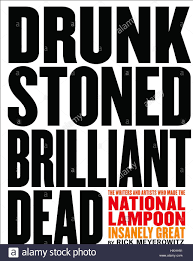
DRUNK STONED BRILLIANT DEAD: THE STORY OF THE NATIONAL LAMPOON.
US, 2015, 98 minutes, Colour.
Directed by Douglas Tirola.
This documentary about the origins and development of The National Lampoon was released on the 50th anniversary of its foundation by Douglas Kenney and Henry Beard.
For those interested in popular American culture, this documentary is a must, introducing the personalities behind the magazine, the development of its satire, articles, illustrations, parody. One commentator noted that practically everyone associated with The National Lampoon in its early days was white male American. On the other hand, another commentator noted: Questionable legacy of burnt-out hippies.
Be that as it may, whether one approves of the humour or not, this is a visual document, a great deal of footage of the 1960s and 70s, interviews with all those involved with the development of the magazine, its transition to radio, the move into films. And, all the while there is the parody, no holds barred in subject and treatment, visuals of the young audiences at the time enjoying the humour. In a way it was you name the possibility, we’ll do it, and more.
There was also the transition to the stage, and the film offering a revelation of the presence, oddball and drugged, of the independent ever-client John Belushi. Chevy Chase also features strongly, thinking back over the decades, the style of humour, the lifestyle, and Douglas Kenney being his best friend and his unexpected death in Hawaii. Also featuring are Bill Murray, Brian Doyle Murray, Harold Ramis, Gilda Radner, and the introduction to Ivan Reitman. There are also genial interviews with John Landis in connection with Animal House, also with Kevin Bacon, with Beverly D’Angelo in connection with the Vacation films.
A great deal of attention is given to the transition to films, the reactions to the themes and treatment of Animal House, sequences from the film. Chevy Chase also featured in the Vacation films.
While the success of the magazine reflected the upheavals and changes of taste, sexual freedoms, the proliferation of drugs in the 1960s and 1970s, there was a change of pace from the 1980s, attempts to rediscover the original impetus.
There are many interviews with editors, executives, financial backers, writers, or reminiscing about their life at the magazine, ups and downs, Douglas Kenney absenting himself for a year, the sale of the magazine, Kenney becoming more involved in films, including Caddyshack (with sequences). The film also shows how Michael O’Donoghue, writer, severed himself from National Lampoon and became the chief writer for Saturday Night Live, with many of the cast transferring to the beginnings of that most successful television program.
Mum's List
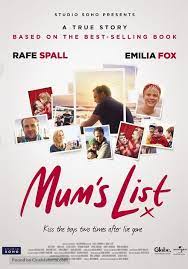
MUM’S LIST
UK, 2016, 101 minutes, Colour.
Rafe Spall, Emilia Fox, Elaine Cassidy, William Stagg, Matthew Stagg, Richard Cordery, Susan Jameson, Ross MacCormack, Sophie Simnett, Bobby Lockwood.
Directed by Niall Johnson.
Mom’s List is a moving British drama, a true story, based on a book by St John Greene, the widower of Kate, who died of breast cancer, a book in collaboration with their friend, Rachel Murphy.
The centre of the film is Kate’s diagnosis of breast cancer, encouragement that it could be controlled, the various stages of chemotherapy, the news that there would be no improvement, her preparation for death. A happy woman, caring for her two sons, experiencing the anguish of the older boy’s cancer before he was six. She has bonded for many years with Singe. There are many scenes showing their life together, happy times, the bonding with their children, happy scenes at the beach.
The film focuses on Singe, played by Rafe Spall, Kate played by Emilia Fox. Singe is a devoted husband, a caring father during his wife’s illness, and, especially, after her death. He tries to put into practice all the notes and advice she left for him, her list. There is a sequence of pathos with Emilia Fox talking to camera, offering all her suggestions and advice for what is to happen after she dies.
There is support for Singed and the boys from a friend from teenage, Rachel, as well is from families.
(This reviewer identified especially with the film, having had the same kind of experience in the 1940s, mother dying, father surviving, two brothers having to cope. However, in those days, there were few visits to the hospital giving some memories but the two boys 7 and 5 at the time. And children did not go to funerals in those days. And, religiously, the anniversary of the mother’s death could be seen as the equivalent of a saint’s feast day in the church. It is interesting to note that in this film, her memory is preserved in much the same way with a celebration of Mothers’ Day.)
Mum’s List can be recommended for its feeling, its empathy towards the dying mother, its presentation of a supportive father, the role of the boys. Audiences will be moved.
- The title? The American title, Kate’s comment, Acres and Acres?
- The British setting, the town, home, hospitals, the beach, the coast? The musical score?
- True story, the personal memoir, Singe and the story of Kate’s illness, death, children, the experience and survival?
- The structure of the film: Kate and her diagnosis, consultations with the doctor, seeming improvement, decline, hospital, death; the flashbacks to Kate and Singe as teenagers, meeting, falling in love; the flashbacks to Reef’s cancer and coping; the flashbacks to the happy life of the family, outings, meals, sharing; the aftermath of Kate’s death, the funeral, Singe as the single father, the boys and their ages, the bonds, having to cope, Singe and his sadness, but supporting the boys? Rachel, a device, the prospect of going out and socialising again?
- Kate, strong woman, the teenager, with Singe, Rachel and the photo, the mementos? Pregnancy, birth, coping with Reefs cancer? Love for Singe, preparing for death, preparing all the notes? The monologue sequence with her wishes for Singe and the boys?
- Singe, middle-aged, memories of teenage, a life with Kate, the boys, Reef’s cancer, her diagnosis, his coping, support? His grief, the funeral, the aftermath, sadness in himself, the mementos, helping with the boys, putting into practice Mums List?
- Rachel, friendship from the past, her support, advice, Singe to go out again (and remove the tie)?
- Singe, friends with Bobby, the meetings and discussions? His family, the gatherings? The final gathering, celebrating Mothers’ Day as a memento? The family photo?
Clemency
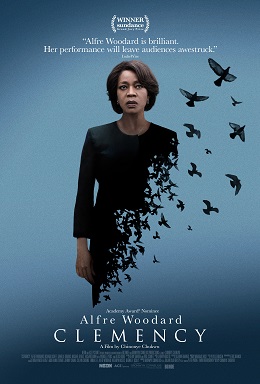
US, 2019, 112 minutes, Colour.
Alfre Woodard, Aldis Hodge, Richard Schiff, Wendell Pearce, Danielle Brooks, Michael O'Neill, Richard Gunn.
Directed by Chinnye Chukwa.
As the title suggests, this is a strong film about clemency from authorities in the case of those condemned to be executed. The film does not pull many punches, opening with an execution sequence in some detail, the reality for the condemned man, the presence of the staff, the role of the chaplain, the paramedic for the injection – and the injections failing and to find other places for the injection, ultimately the death, the impact on everyone of the botched procedure.
The focus of the film is on the warden, Bernadine Williams, one of her best serious performances by Alfre Woodard. She is serious about her job, no exceptions, the letter of the law. The prison has 1000 inmates, 12 on death row. We see her at work in her office, discussions about the media and visitors, confronting lawyers, her visiting Anthony Woods (a moving performance by Aldis Hodge) who is about to be executed. She meets the parents of the victim and refuses permission for the grandson to be present at the execution, despite appeals to her emotions, exceptions.
Her work takes a toll on her, she goes to a bar to drink, she has been married to her husband for some time (a sympathetic performance by Wendell Pearce), cannot sleep, becomes more alienated from her husband who sees her as a shell of herself and leaves. There is the possibility for reconciliation.
The film focuses on Anthony Woods, the issue of whether he was guilty or not, the continued support of his lawyer, a sympathetic performance by Richard Schiff, a lawyer who is becoming weary of his work after 30 years and the continued frustrations. There is a strong scene where he confronts Bernadine in her office.
There is a rehearsal for the next execution, Bernadine’s deputy standing in as the man to be executed. Then there is the reality of the execution, the role of the chaplain (whom Bernadine has visited for advice), the staff, the paramedic. However, while Anthony Woods is dying, there is a long, very long, close-up of Bernadine’s face, the audience reflecting on what she is thinking and feeling. All the formalities are finished – and Bernadine walks down the corridor, to what future? Some clemency or her continued sense of conscientious observing of rules and regulations and the law?
- The title? The theme? In the context of capital punishment, executions?
- The American city, the state with capital punishment? Homes and bars? The musical score?
- The prison, the plant, exteriors and interiors, corridors, cells, offices? Rooms for visitors? The detail of the execution room, the equipment, rehearsals and testing, the actual executions? The observers?
- Alfre Woodard’s portrait of Bernadine Williams, warden, conscientious, the letter of the law, no exceptions? Relationship with her staff, her Deputy and the discussions, the media? Her visit to the prisoners, especially Anthony Woods? 12 men on death row? Seeing her at work, the contrast and her going to the bar, her drinking, conversations? Meeting with the deputy? Meeting with Marty? At home, her relationship with her husband, long-standing, his support, her nightmares, watching television in the night, feelings of alienation from her husband, the discussions, her not wanting to be touched, his feeling she was a shell of herself, her going to the school to meet him, his rejection? His coming home, together, attempts at support? His opinions?
- Anthony Woods, the accusation, the killing, found guilty, 15 years in prison, death row? As a person, generally well-behaved? Marty and his support, hopes for clemency? His relying on Marty and his presence? Sense of despair, banging his head on the wall, to hospital? The letter from his partner, the revelation about his son, the photo, her visit, his response, her not being sorry, his walking away? The possibility for his son to visit, not turning up? The discussions with the chaplain, his support?
- The demonstrators against capital punishment, the vigils outside the prison, their placards, “I am Anthony Woods”?
- Marty, 30 years a lawyer, his cases and causes, the visits to Anthony, discussions, support, confrontations with the warden, his decision to retire, Anthony thinking he was walking away? Walking past the protesters? On television and his opinion? Hopes, presence at the execution?
- Bernadine and her husband, at home, his leaving, her going to the school, the glimpse of him at school and the poem about what people see and don’t see?
- The assistant warden, supporting Bernadine, volunteering for the rehearsal of the execution? The prospect of his having a better job? Applying?
- The chaplain, his role, the prologue and his support of the man to be executed, prayer, touch? Bernadine going to see him at the church, the discussions about his retirement, his wife having had enough? The toll on himself? The return to the prison, comforting Anthony, the text? His presence at the execution?
- The initial execution, the detail, the procedure, strapping the prisoner, the microphone and comment, the witnesses, his mother? The injection, the failure, searching for a possibility, ultimate death? Public reaction and media reaction to the botched procedure? As a grounds for clemency for Anthony?
- The visit of the parents of the murder victim, the emotional plea, the grandson to witness the execution, Bernadine and her staunch refusals? Their coming to the execution?
- The rehearsal for the next execution, the deputy standing in, the man with the switch unable to carry on, leaving?
- No reprieve, Bernadine, Anthony strapped in, his declaration of innocence, office of compassion, the doctor, the injection?
- The final close-ups of Bernadine, the long time with the camera on her face, her expressions, her reactions, while the execution was taking place? Her job, her conscientious attitude, her understanding more of Anthony Woods, the reality of capital punishment? The aftermath of the execution, formalities done, Bernadine walking down the corridor – and what she would do in the future?
Anna/ 2019
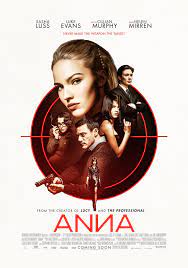
ANNA
France, 2019, 118 minutes, Colour.
Sasha Luss, Helen Mirren, Luke Evans, Cillian Murphy, Lara Abova, Eric Godon.
Directed by Luc Besson.
Over many decades, French writer-director Luc Besson has made a number of action films. In the 1990s, he created a female agent, La Femme Nikita. He also made a film about Joan of Arc as well as producing a great number of action shows like the Transporter series. He had various excursions into science fiction, science-fantasy, The Fifth Element, Valerian and the Thousand Planets.
With this film he returns to the tough female agent. Anna is played by Russian actress, Sasha Luss. There is an international supporting cast led by Helen Mirren as her control in the KGB, Helen Mirren relishing the severe operative, making huge demands on her agents. On the Russian side there is Luke Evans. On the American side, the CIA, there is Cillian Murphy.
The main aspect of the impact of the film is the construction of the screenplay. It continually moves backwards and forwards, giving explanations, further revealing details of plot, many of which are quite expected. As the audience puts together the pieces of Anna’s career, we see how she was recruited by the KGB, trained, under contract, tested very severely, under minute surveillance, sent to Paris as a model, but also as an assassin, observed by the CIA.
As the film progresses, with the moving to and fro in time eras, there are quite a lot of twists, agents, double agents, double double agents. While these aspects are quite interesting and entertaining, there are very grim fights, weapons, martial arts tactics, a high death count. Very much a Luc Besson film.
- The films of Luc Besson, action films, espionage films, mysterious female leads? This film in that tradition?
- The international settings, Moscow, Paris, Spain, the touch of the exotic, the mysterious? The musical score?
- The time structure of the film, going backwards and forwards, revealing more and more information, the twists and the double agents?
- Anna, her background in Russia, the introduction, at the stall, persuaded to become a model, going to Paris, her career and success, her murdering the businessman? The flashbacks and the flash forwards, her background, recruiting, interviews with Olga, proving herself, persuaded to become a killer, the training? Recruited by Alex, her relationship with him? Lenny Miller, the CIA, cat and mouse? Each side observing Anna, Olga and her continued surveillance, Alex, Lenny, her being trapped, the capacity for manipulation?
- Anna, training, ability with weapons, the contract, her jobs, the timing, the restaurant and Olga waiting five minutes, the attack, the mission, her fighting, killing, getting more commissions? The film interspersed with these fight scenes?
- Anna, fashion, her capacity as a model, the fashion shoots, the critical photographer and her turning on him? Friendship with Maude, the sexual relationship, out with her? Anna using her as cover? The holiday together?
- Olga, her control, personality, her limp? Ever-present? Using Alex? The KGB chief, Anna playing chess? In the American pressure, her killing him, the escape?
- The mistake on the mission, the issue of her watch, the delay, the Americans pressure on her, Lenny and his personality, his relationship with Anna, at the resort, at the end?
- Olga, shrewdness, turning Anna back again, her taking the place of the chief? The irony of Anna taping Olga, and Olga admiring this?
- The finale, Alex and Lenny, the meeting in Paris, the setup, Anna and her eluding them?
- The blend of espionage, perspectives on the KGB, on the CIA, and the introduction of the violent assassinations and fight sequences?
There's Someone Inside Your House
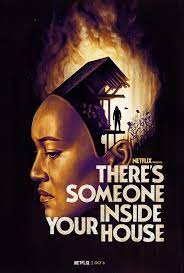
THERE’S SOMEONE INSIDE YOUR HOUSE
US, 2021, 96 minutes, Colour.
Sydney Park, Theodore Pellerin, Asher Cooper, Dale Whibley, Jesse La Tourette, Diego Josef, Zane Clifford.
Directed by Patrick Brice.
Continuing the tradition of the slasher film, the slasher film set amongst high school students, football matches, socials, and Nebraska corn fair… As many have commented, it has all been done before!
The title is somewhat misleading although strictly apt in the prologue, rather eerie haunting of a footballer and then his ankles being slashed. Later, the killer does come inside the leading lady’s house. Otherwise activity is not in the house.
This is a variation on the theme, and then there were none. The second killing takes place in a Catholic Church, the priest opening the door and the congregation finding a girl hanging, rather prissy girl who felt that she was a leader at school. There are later mysterious killing of a young boy who is on tablets. Then the heroine is threatened. The situation seems to be that each has a secret that they are trying to conceal that needs exposing.
For most of the film, the suspect seems to be the leading teenager’s boyfriend, brother of the sheriff. He looks suspicious, rather thin and weedy. He is even arrested. However, there is another character within the group, the son of the local entrepreneur for farm corn sales. He is the killer, sets the cornfield alight, murders his father, is completely resentful, hence the murders.
This is the kind of review where one says, if you like this kind of thing…
Siloam, Spiritual Direction program, Heart of Life, 2021
Siloam, Spiritual Direction program, Heart of Life, 2021

Only a month to go for the 2021 Siloam program.
Tru and Danh can be seen in the full-time group.
Khoi is amongst the part-time group. There is a wide range amongst the part-timers with the course this year on Zoom.

Enquiries and enrolments for 2022 welcomed.
Heart of Life Centre for Spiritual & Pastoral Formation
Kildara Centre
Rear 41 Stanhope Street
Malvern VIC 3144
(Telephone remains as (03) 9890 1101)
Witch Hunt/ 1994

WITCH HUNT
US, 1994, 100 minutes, Colour.
Dennis Hopper, Penelope Ann Miller, Eric Bogosian, Sheryl Lee Ralph, Julian Sands, Debbie Mazar, John Epperson (Lypsinka).
Directed by Paul Schrader.
Witch Hunt is a film by Paul Schrader, one of his lesser-known films, made for HBO television during the 1990s, one of a slew of very interesting HBO films of the 1990s and the early 2000s. It was written by Joseph Dougherty – and is a follow-up to his HBO film of 1990, Cast a Dark Spell. Both films are set in LA, have private detectives in the vein of Philip Marlowe and Sam Spade (here with an obvious homage, Philip Lovecraft).
In both screenplays, magic is prevalent in Los Angeles – with the setting here in the 1950s and allusions to film noir of the period. Tp, with Richard Conte is from The Big Combo. Nina Simone sings I Put a Spell on You.
Dennis Hopper is the private detective. Penelope Ann Miller is the femme fatale, married to an unfaithful film producer who is murdered. The film opens with commercials of the period all talking about magic in terms of cleanliness of the house. But, there is a carbon, especially with a witch played by Sheryl Lee Ralph, who shares an office with Lovecraft.
There is an investigation, the producer is the victim of magic, shrinking and then being killed. There is beach house which serves as a bordello, managed by transvestite actor, John Epperson (Lypsinka) as well as a sinister Irish magician played by Julian Sands.
The complication comes with a Senator who is having a very public campaign against magic. His played by Eric Bogosian. However, he is gradually unmasked, and magic in the middle of a huge rally has him shrinking and then his real, black garbed self emerges, showing that he despises the public. With his investigations, and the plan for a literal witch burning, is reminiscent of Senator Joe McCarthy and his anti-Communist investigations of the period.
An oddity in itself but also for Paul Schrader.
- The title, expectations? Los Angeles, the 1950s?
- The city of Los Angeles, views, offices, public gatherings, politics? Mansions, the beach? Musical score?
- The opening, the theme of magic, the television commercials and the talk of magic, the information that magic was prevalent in Los Angeles, the covenants, incantations, the rituals, bringing up Shakespeare and Dickens? The shrinking of the producer and his death? Mysterious eyes? Snakes and frogs?
- The basic film noir, familiar material, the actress, her philandering husband, the casting couch, hiring the investigator, his style, following clues, stakeouts, his past use of magic that his refusal to use it after? Sharing the office with Hippolyta? Her being a witch, the cupboard, raising Shakespeare, accompanying Lovecraft? The revelations about the actress, the past, the sexual rendezvous, the Madame? The Irish magician and his presence and power?
- Dennis Hopper as Lovecraft? The name? The parallels with Philip Marlowe and Sam Spade? The visit from Kim, the glamour, hiring him, the death of her husband, following Lovecraft, not wanting him to go to the beach house (and her past there)? The past with Macha, vindictive, his eyes? At the beach house, moving in and her management? The girls? The later revelations about senators and rendezvous, choosing the girls, the magic of changing their appearance and personality? Deaths?
- Kim and Marie, Marie mysterious, the car, the death?
- Senator Larson Crockett, personality, his campaign against magic, advertisements, speeches, the huge rally? The blackmail deal with Macha? Macha and his revenge, the senator’s collapse, his inner self emerging, haranguing the crowd, abusing the crowd? Both personalities arrested? The double standards, hypocrisy – and echoes of Senator McCarthy?
- The campaign against Hippolyta, her being taken, at the rally, to be burnt at the stake? Match are changing the situation, Lovecraft freeing her?
- Macha, the visions of Kim and the attempted murder in the bath?
- Lovecraft, not exercising the magic, Hippolyta saving him?
- Kim, back to normal, disappearing from the movie scene?
- The play on the film noir and the private detective?
Hold the Dark
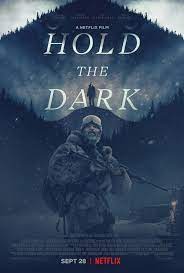
HOLD THE DARK
US, 2018, 125 minutes, Colour.
Jeffrey Wright, Alexander Skarsgaard, James Badge Dale, Riley Keogh, Julian Black Antelope, Tantoo Cardinal.
Directed by Jeremy Saulnier.
Hold the Dark is directed by Jeremy Saulnier, who made an impact with small budget horror films, Blue Ruin, The Green Room. This film works on a far vaster scale, with his Alaskan settings, filmed there as well is in Calgary, remote towns, Native American population, forests, mountains and ever-present wolves.
Jeffrey Wright portrays Core, an expert on wolves who is invited to come to Alaska by a woman who declares her son, like of the boys in the town, has been taken by wolves and killed. He accepts and moves into a strange atmosphere, the woman puzzling in her ambiguous provocative behaviour and her disappearing. He goes in pursuit of the walls, encounters them, a stance between them but they run away. A woman in the village warns that the wife is evil and that is going on the wrong direction. Core discovers the body of the boy in the basement, strangled.
There is a transition to show the father, Vernon (Alexander Skarsgaard) on patrol, confronting rebels, his killing a fellow soldier who is raping a local woman, his being wounded and repatriated. He meets up with a Native American friend, Cheon (Julian Black Antelope). What follows is somewhat bewildering, Cheon complaining about harsh government attitudes and prejudices for the village, his going on a shooting spree and killing and wounding many of the local police.
Core is asked to stay by the sheriff (James Badge Dale) and is witness to the shooting. Vernon is also responsible for shootings and flees to some springs on the mountain where he teams up with his wife. Again, violence, confrontations – but, with Core surviving, rescued and finally reunited with his daughter.
Often very grim, some very brutal sequences, and the puzzle about the spirit of wolves, their possessing humans, and all the traditions of the folklore about wolves, full moons, the Wolfman.
- A dark film? Gruelling subject, situations?
- The Alaskan settings, forests, mountains, snow? The isolated towns? The musical score?
- The wolf theme, traditions about wolves, Wolf man, full moons, legends and myths, the spirit of wolves, prowling, destructive?
- The introduction to Core, his expertise on walls, his career, the message from Medeora, his decision to travel, arrival, the village, the Native Americans and their presence, the discussions with Medeora, the situation about her son, her talking, her husband absent at war, the wolves and her son, her manner, the night, the bath, naked, lying on the bed? Urging Core on his quest? His return, the disappearance?
- Going on his mission, prepared, the Native American woman warning him evil, going the wrong way? Trekking through the snow, the encounter with the wolves, eating the young, his falling, reaching for the rifle, the wolves approaching, their stands, withdrawing?
- Core in the house, discovering the boy’s body, calling the police, the coroner? His bewilderment?
- The transition to the war, the mission, Vernon and his presence, the pursuit, the crashed car, the rebels, shot? In the town, wandering, the soldier raping the woman, killing him, giving the woman that night? His being shot, wounded, the blood, rescued, repatriated? The flashbacks and the memory of being with his son?
- Vernon’s return, the meeting with his friend, Cheon? The meeting with the sheriff, with Core, thanking him and shaking his hand? The body of his son, digging it up and taking it? The shooting of the coroner?
- The social background, the government, illness among the Native Americans, Cheon and his complaints? Taking up weapons?
- The siege, the police, the tactics of the sheriff, core and his involvement, under the car? Cheon and his weapons, the number of deaths, police wounded? The sheriff, his tactic, getting into the building, cutting the trip wire, confronting Cheon, shooting him? The young police officer, his fears, having to run, shot, rescued?
- The mystique of the wolves, with Vernon and his wife, the murder of the child, the evil spirit possessing? Their going to the springs?
- The sheriff, Core, the plane, pursuing Vernon, going to the springs, the sheriff killed? Core wounded? Going into the cave, seeing the setup for Vernon and his wife? His being wounded in the neck?
- Vernon, his wife, the relationship, power, sexuality, the springs? Vernon withdrawing the arrow from Core’s neck?
- Vernon and his wife, going into the wilderness?
- Core, rescued, transferred, in the hospital, his daughter present?
- The unexpected aspects of the drama? Remoteness, Alaska, the walls and mystique?
